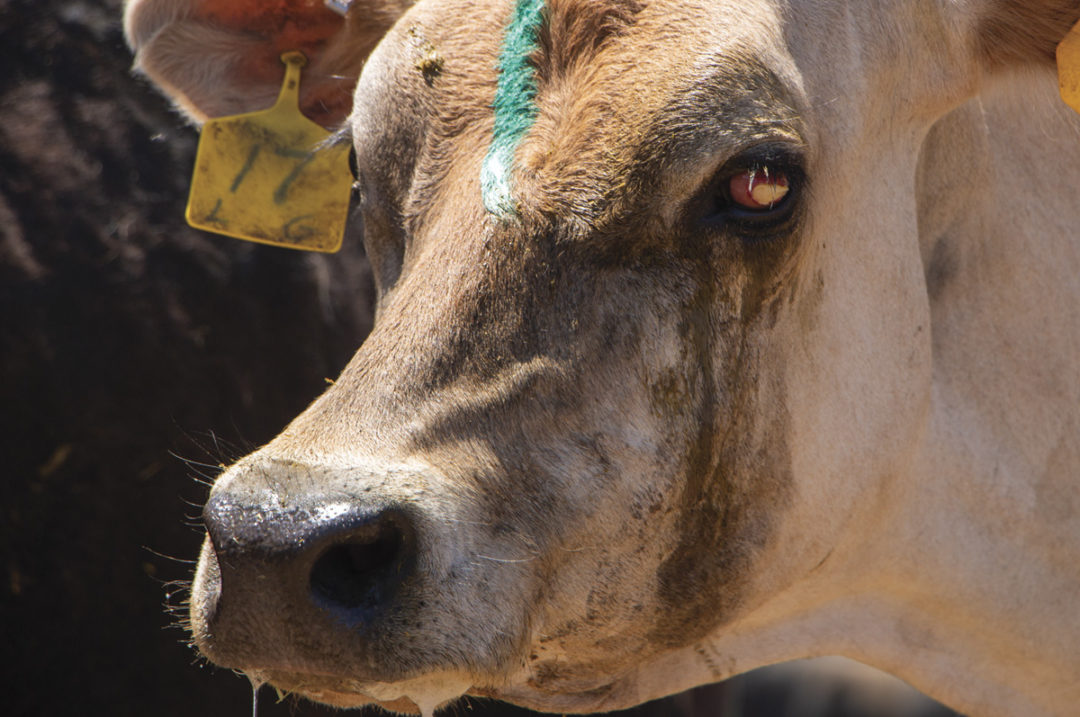Hate dealing with pinkeye? Isn’t it a summer issue ... why do outbreaks occur at unusual times of the year? Pinkeye is a disease adding frustration to the dairy sector. The impacts of the condition to infected cattle and the industry are significant. With potential for multiple pathogens to be involved and a variety of environmental risk factors, identifying effective solutions is a challenge. Over time, multiple strategies have been proposed, and while no single idea has adequately addressed the problem, using a combination of techniques to reduce the risk of disease has surfaced as the best approach. These measures include practicing good housing management, fly control, trace mineral supplementation and vaccination.
The problem
Pinkeye or infectious bovine keratoconjunctivitis (IBK) is an infectious disease that damages the eye and leads to inflammation of the eyelids in cattle. Historically, Moraxella bovis has received the most attention as the bacteria causing pinkeye. While it is considered a primary pathogen, other bacteria like Moraxella bovoculi and Mycoplasma bovoculi may be involved. Viruses such as infectious bovine rhinotracheitis (IBR) can affect the same tissues as well. Mixed infections are common. Strain variation among each type of bacteria adds to the microbial diversity.
Cattle serve as the carriers for these organisms. With face flies acting as vectors and spreading pathogens around, summer is the highest risk period, although outbreaks can occur year-round. Direct contact between animals can account for spreading the organisms other times of the year.
Exposure to sunlight, wind, dust, ammonia and sharp objects within pens may injure the eye. Stressors such as weaning, pen moves and overcrowding diminish the ability of the immune system to ward off invading pathogens. Clinical signs are seen when the bacteria combine with a damaged eye surface. Youngstock tend to be more commonly affected, but cattle in the lactating herd can also develop the disease. While all breeds are at risk, genetics may influence susceptibility.
What to do about pinkeye
With environmental conditions playing a significant role in pinkeye, it may seem daunting to address. The likelihood of trauma to the eyes can be reduced by providing shade and focusing on careful bedding management. Strategically placed shade meshes can help limit the intensity of sunlight. When refreshing pens, avoid blowing bedding into the areas when animals are present. As bedding and manure accumulates, removing the waste will help minimize ammonia levels. Maintenance of hutches, fences, railings, stanchions, tiestalls and freestalls is just as critical. Not only do pen moves and overpopulating animal areas contribute to stress, these practices may also enhance the spread of bacteria that occurs through direct contact. Creating groups of animals that fit the pen spaces with minimal mixing between groups has health benefits beyond just controlling pinkeye.
Combating face flies is similarly difficult because some fly control options are only suitable for certain fly types. Frequent application of insecticides which are approved for use in dairy will have the greatest impact for pinkeye. Insecticides can be sprayed directly on the cattle or applied to the environment through premises sprays.
Trace minerals such as zinc, copper and selenium have a role in immune function. When intake of these elements is optimized, adequate body stores are maintained which the animals’ natural defense mechanisms use to fight infection. The regional differences and variation of nutritional content within feedstuffs adds some complexity to ensuring that needs are met, especially for cattle that spend a portion of their lives living in one geography and then move to another, even if it is only temporary. Even though trace minerals have likely been added to the feed of cattle receiving a total mixed ration (TMR), the diet should be periodically evaluated for nutrient content. Working with a nutritionist will help ensure that supplementation is appropriate.
Vaccination is another component to include in a management system aimed at reducing the incidence of pinkeye. Helping the immune system better recognize pathogens when they invade the corneal surface of the eye is essential in stopping the progression to a more severe lesion. Beyond simply reducing the likelihood of pinkeye, vaccination may also help reduce the severity and duration of disease. There are commercial and autogenous vaccines available. Due to limited cross-protection between the different bacteria and strains of each organism, the best vaccine option is selected based on matching a product to the specific microorganisms causing the problem. Commercial vaccines only tend to include one type of organism with a limited number of strains, while autogenous vaccines can be custom-made to include what is found in an infected herd.
Utilizing a veterinarian, collecting samples and submitting to a diagnostic laboratory will provide valuable insight into the dynamics of the disease process. When outbreaks occur, culture and sensitivity testing can be used to select the most appropriate antibiotic therapy. Some laboratories offer polymerase chain reaction (PCR) testing and genetic sequencing that sort out which bacteria and strains are present. Once this diagnostic data is obtained, it can be combined with the expertise of a veterinarian to find workable solutions.
A veterinarian is necessary in developing the appropriate vaccination schedule for each herd. Understanding the bovine immune system will allow him or her to advise on timing of vaccination. Knowing when to start vaccinating is just as important as knowing when to booster. Antibodies decay over time, and determining the appropriate interval between vaccinations will help minimize break-through infections. There is limited data available but some information to suggest vaccinating once a year for pinkeye is inadequate. Given the possibility of waning protection and the potential for spread of the bacteria through direct contact during commingling events, it may be advantageous to vaccinate youngstock prior to weaning and again at about 5 to 6 months old.
Management plan
Like any disease process, having a strategy provides a roadmap for dealing with the problem. Finding the right tools that contribute to successful outcomes is the goal. Pinkeye requires a multifaceted approach.
-
Housing management: Maintain fresh bedding, minimize creating dust, limit pen moves as well as overcrowding and keep facilities in good repair.
-
Fly control: Focus on insecticides that are approved for use in dairy that specifically address face flies.
-
Trace mineral supplementation: Ensure that quality micronutrients intended in ration formulations are actually available for consumption 365 days a year.
- Vaccination: Administer products ahead of the risk period for disease that offer protection to the organisms and strains that are specific to the herd.
A concerted approach with assistance from nutritionists and veterinarians will greatly enhance any plan. Making sure that all steps are implemented fully is key to reducing the impact of pinkeye as well as the frustration that goes with it.







